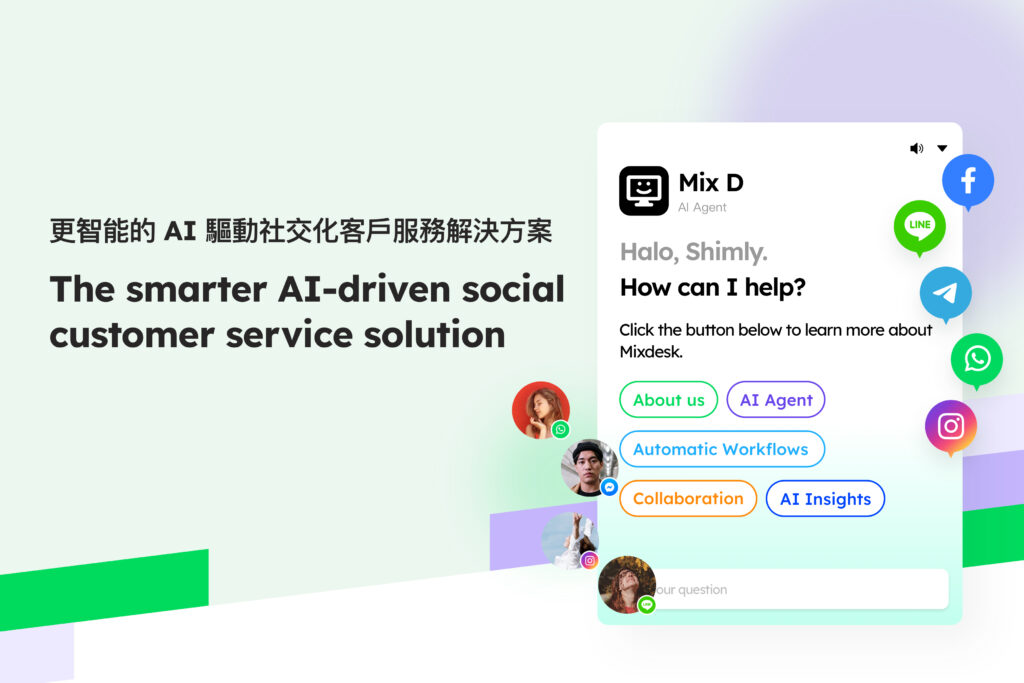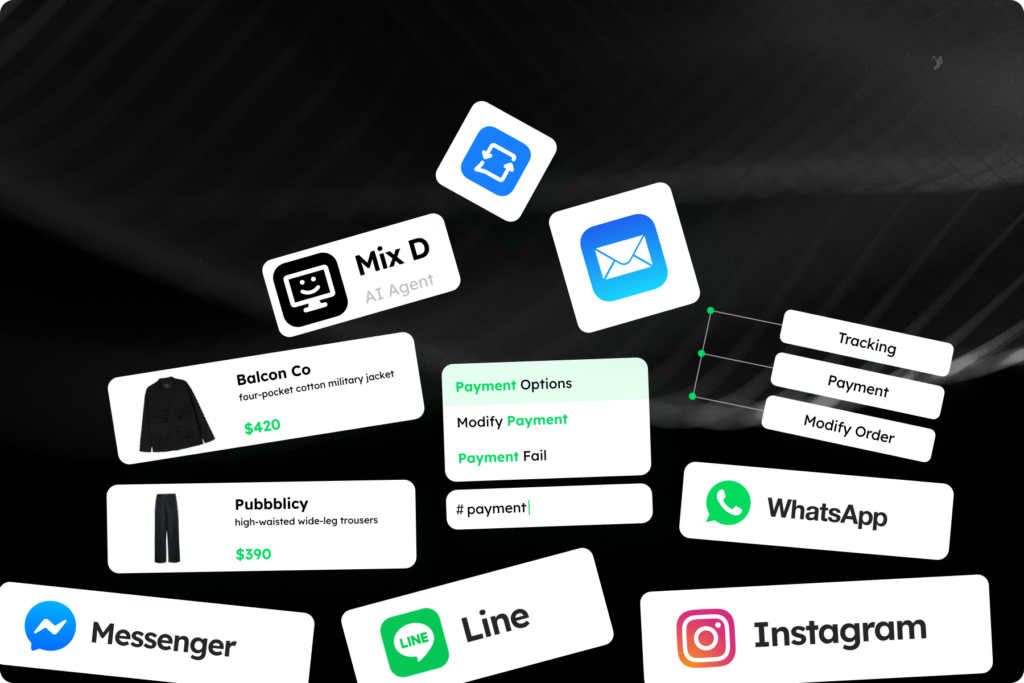Author of this article:Miya, Search engine optimization expert
As the cross-border e-commerce market continues to heat up, companies are facing the process of going overseas.Customer service challenges are increasingly complex。 Language differences, inconsistent time zones, and decentralized multi-platform communication make it difficult for traditional customer service tools to meet the needs of cross-border business. In order to improve the user experience, improve service efficiency, and support the development of business globalization, more and more brands have begun to deploy professionalCross-border e-commerce customer service system。
This article will focus on the core functions, typical application scenarios, selection points and future trends of the ”cross-border e-commerce customer service system" for in-depth analysis to help enterprises more scientifically understand and apply this key tool.
Mixdesk
AI Agent

- 1. What is the cross-border e-commerce customer service system?
- 2. The core functions of the cross-border e-commerce customer service system
- 3. Why do companies need to deploy cross-border e-commerce customer service systems?
- 4. Typical application scenarios of cross-border e-commerce customer service system
- 5. How to choose a suitable cross-border e-commerce customer service system?
- 6. The future trend of cross-border e-commerce customer service system
- 7. Recommended choice: MixDesk cross-border customer service solution
1. What is the cross-border e-commerce customer service system?
Cross-border e-commerce customer service systemIt is a customer service platform designed for international business scenarios, with functions such as multilingual translation, message integration, automatic response, customer management, and data analysis. Compared toLocal e-commerce customer service system, Which emphasizes language adaptation, multi-platform access and intelligent operation, the goal is to help enterprises achieve efficient communication and closed-loop service for global customers.
2. The core functions of the cross-border e-commerce customer service system
A mature cross-border e-commerce customer service system usually includes the following core modules:
1. Multi-language translation support
Built-in systemReal-time translation function, Can recognize and convert multiple languages (such as English, French, German, Spanish, etc.) to facilitate barrier-free communication between customer service staff and users in different languages.
2. Multi-platform message integration
Support will come from Facebook、Instagram、WhatsApp、Messenger Customer messages from social platforms such as Wechat are uniformly aggregated into one background to achieve unified cross-platform replies and improve processing efficiency.

3. Automated reply and robot service
Through the preset common problem library and automatic response logic, it is realized7×24 hours smart reply, Solve repetitive issues such as order inquiries, logistics progress, after-sales policies, etc., and relieve the pressure on manual customer service.
4. Work order management and customer labeling system
Automatically generate work orders for customer issues, support label classification, prioritization, and status tracking, and help to standardize service processes and optimize team collaboration.
5. Data statistics and performance analysis
Built-in visual data kanban board, providingMessage response time, Multi-dimensional analysis of customer service satisfaction, user activity, etc., to help companies continuously optimize the performance of customer service teams.
|Related reading|
3. Why do companies need to deploy cross-border e-commerce customer service systems?
Cross-border business is different from local business in that its service chain is longer and communication is more complex.Traditional customer service systemThe limitations are particularly obvious in the cross-border environment, such as:
- Customer service cannot handle multilingual customers, affecting the quality of communication;
- Multiple back offices need to be switched on different platforms, and the management efficiency is low;
- Time zone differences lead to long customer waiting times and decreased satisfaction;
- The dispersion of after-sales data is not conducive to the maintenance of customer relationships.
andCross-border e-commerce customer service systemThrough an integrated and multilingual intelligent response mechanism, it can be significantly improvedProfessionalism and continuity of customer service, thereby enhancing user trust and brand stickiness.
4. Typical application scenarios of cross-border e-commerce customer service system
The following types of enterprises or teams have a high degree of dependence on cross-border customer service systems in actual operations:
- DTC brand: To carry out overseas direct sales business through self-built independent stations, private domain customer service support is required;
- Social media sellers: in Facebook, Instagram and other platforms for product promotion and pre-sales services;
- Cross-border live broadcast team: Via video/live broadcastAttract overseas users and guide transactions, Need real-time private message management;
- After-sales service center: Responsible for the unified processing of refunds, exchanges, logistics and other service processes, requiring strong systematization and high efficiency.
|Related reading|
5. How to choose a suitable cross-border e-commerce customer service system?
To choose a suitable system, it is necessary to make a comprehensive judgment based on the dimensions of the enterprise's business volume, service needs, and technical capabilities. The following are a few recommended reference factors:
1. Platform compatibility
Give priority to supporting the platform you are currently using (such as WhatsApp, Messenger)、Facebook Etc.) of the system, and has the ability to continue to expand.
2. Translation accuracy
Automatic translation is just needed for cross-border customer service systems. It is recommended to choose products that support context optimization or industry thesaurus customization to ensure translation accuracy.
3. Degree of intelligence
Whether the system has the capabilities of robot training, dialogue process configuration, and FAQ customization determines whether it has the ability to train robots, configure dialogue processes, and customize frequently asked questions.Complex customer service scenariosThe degree of adaptation.
4. System integration capability
Whether it can be seamlessly integrated with internal tools such as ERP, CRM, and order system affects the overall data flow and service efficiency.
5. Data security and compliance
Whether it has passed international certifications such as GDPR and ISO 27001, and whether it hasLocalized deployment capabilities, It is related to the long-term compliance and operation ability of the enterprise.
|Related reading|
6. The future trend of cross-border e-commerce customer service system
futureCross-border customer service system, Is no longer just a tool-based product, but will gradually evolve into an intelligent operation assistant, showing the following development directions:
- AI capability enhancement: More accurate semantic recognition and contextual understanding ability, improve the quality of automated responses;
- Customer behavior insights: Form customer portraits based on chat records and behavioral data to achieve precision marketing;
- Automated work order distribution: Combine customer intentions and problem types, and intelligently assign them to different customer service teams to deal with;
- Closed loop of operational data: From customer service dialogue to sales conversion, the data chain drives business growth in a closed loop.
The earlier the enterprise deploys and uses it proficientlyCross-border e-commerce customer service system, The more you can take the initiative in the highly competitive global market.
|Related reading|
7. Recommended choice: MixDesk cross-border customer service solution
As an intelligent customer service platform for cross-border scenarios, [MixDesk] Focus on solving the efficiency and service quality problems of enterprises in the process of multilingual, multi-platform, and multi-time customer service.
Its system has the following core advantages:
- Support message integration on four platforms: Facebook, Instagram, WhatsApp, and Messenger;
- Provide high-quality semantic translation and industry thesaurus;
- Built-in robot configuration, customer labeling system, data analysis kanban board;
- Can be connected to e-commerce ERP and CRM systems to open up business links;
- Support global compliance standards and ensure data security.
Whether you are a DTC brand, a social media seller, or a cross-border team,MixDesk Can provide you withOne-stop cross-border customer service solution, To help the efficient development of global user services.

Mixdesk is an overseas multi-channel intelligent customer communication platform that can unify multiple channels such as Facebook, Instagram, WhatsApp, Line, Telegram, and Email to help companies communicate and serve customers. Mixdesk also supports AI employee functions, allowing enterprises to achieve more efficient automated customer service.
Conclusion: In today's continuous release of cross-border e-commerce dividends, customer service has become a key variable for brand success. A set of professionalCross-border e-commerce customer service system, Not only a service tool, but alsoConnect customers and increase conversions, The core asset to promote growth.
It is recommended that enterprises pay attention to the construction of the customer service system in the early stage of going out to sea, from selection to landing, and build a service center that adapts to their own pace in order to stand out from the fierce competition.
Extended reading recommendation:
- "Agent Artificial Intelligence is not the future, it already exists! 》
- "How to Sell on Facebook Marketplace: The Latest Guide for 2025"
- "AI Customer Service Evolution Theory: Working Principle, Business Practice and Future Service Ecology Outlook"
If you are still worried about “too many platforms, too complicated content, and too messy private messages”, you might as well try a smarter way to do it well.Social media marketing。
(Want to know more? You can directly add the contact information of the business consultant to obtain an exclusive customer acquisition plan.)



